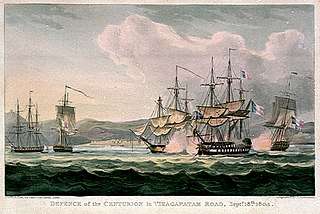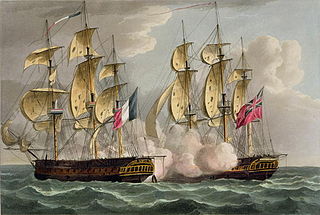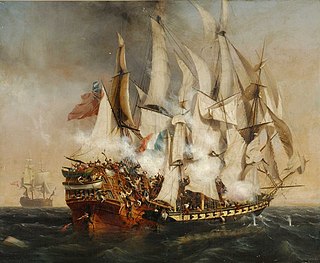
The Sémillante was a 32-gun frigate of the French Navy, lead ship of her class. She was involved in a number of multi-vessel actions against the Royal Navy, particularly in the Indian Ocean. She captured a number of East Indiamen before she became so damaged that the French disarmed her and turned her into a merchant vessel. The British captured her and broke her up in 1809.
HMS Moucheron was a French privateer, built in 1799, that the British captured in 1801. The British government purchased her in 1802 for the Royal Navy. She foundered in 1807 in the Mediterranean without leaving a trace.

HMS Clyde was a Royal Navy Artois-class frigate built at Chatham Dockyard of fir, and launched in 1796. In 1797, she was one of only two ships whose captains were able to maintain some control over their vessels during the Nore mutiny. In 1805, HMS Clyde was dismantled and rebuilt at Woolwich Dockyard; she was relaunched on 23 February 1806. She was ultimately sold in August 1814.

Résistance was a 48-gun Vengeance-class frigate of the French Navy. HMS St Fiorenzo captured her in 1797 and the Royal Navy took her into service as HMS Fisgard. She was sold in 1814.

Robert was a 16-gun French privateer corvette launched in 1793 at Nantes. The British captured her in 1793 and named her HMS Espion. The French recaptured her in 1794 and took her into service as Espion. The British recaptured her in 1795, but there being another Espion in service by then, the British renamed their capture HMS Spy. She served under that name until the Navy sold her in 1801. Spy then became a slave ship, a merchantman to South America, and privateer again. The French captured her in mid-1805 and sent her into Guadeloupe.
Vautour was a French privateer launched in 1797 at Nantes that made three privateering voyages. The Royal Navy captured her in 1800 during her fourth cruise. Private owners acquired her prior to late 1801 and employed her as the whaler Vulture in the South Seas whale fisheries between 1801 and 1809. A Spanish privateer captured her in 1809.

Confiance, launched in 1797, was a privateer corvette from Bordeaux, famous for being Robert Surcouf's ship during the capture of the British East India Company's East Indiaman Kent. The British Royal Navy captured Confiance in 1805, took her into service under her existing name, and sold her in 1810. Before she was sold, Confiance took part in two notable actions.
Wanstead was launched in 1802. In 1807 a French privateer captured her, but the British Royal Navy recaptured her the next day. Then in 1810 she was again captured by a French privateer, and was again recaptured a few days later. In 1819 she traded with India or China under a license from the British East India Company (EIC). She was wrecked in 1820.
Sorcière was the name of several privateers that sailed during the Napoleonic Wars. Three were French vessels, but one was British, though the British Sorciere was probably the Sorcière launched in 1803 at Saint-Malo that the British Royal Navy captured in April 1806.
The vessel that would become Young William was built in 1791 at Nantes. The British captured her in 1794 and Daniel Bennett purchased her that year. She then went on to make 10 voyages for him. French privateers captured her twice, but on the first occasion the British Royal Navy recaptured her, and on the second her captor did not keep her. Still, the French Navy captured and burnt her in 1810 on her eleventh voyage.
Diamond was launched in 1798 at Quebec. French privateers captured her three times, the third time retaining her. In between she carried slaves. Her third capture occurred while she was on a whaling voyage. Her last voyage took her from Île de France to Bordeaux where she was decommissioned in January 1809.
Frederick was an American-built ship that the British captured from the French c.1805. Lumley & Co. purchased her in prize and employed her as a slave-ship for two voyages. After the abolition of the British slave trade in 1807 she briefly became a merchantman, and then in 1810 a whaler. She made several voyages to the Southern Whale Fishery. On one of these voyages, in 1812, a French privateer captured Frederick but the British Royal Navy captured the privateer, and recaptured Frederick. She is last listed in 1822.
Crescent was launched at Rotherhithe in 1790. She initially traded with the Levant, particularly Smyrna. After the outbreak of war with France she may have tried her hand as a privateer. In 1796–1798 she made a voyage to the East Indies, almost surely on behalf of the British East India Company (EIC). A French privateer captured her but the British Royal Navy quickly recaptured her. In 1802-1804 she made one voyage as a slave ship carrying slaves from West Africa to Jamaica. In 1805 she became a whaler. She was lost in 1807 off Patagonia while homeward bound from her first whaling voyage.
Wilding was launched at Liverpool in 1788 and spent much of her career as a West Indiaman, sailing between Liverpool and Jamaica. During this time, in November 1794, she participated in a single-ship action during which her opponent, a French privateer, blew up. In 1798 after a series of captures and recaptures she briefly became a transport for the French Navy, but a final recapture returned her to British hands. Later, she made one voyage to the South Pacific as a whaler, and one voyage to the Cape of Good Hope as a victualler for the 1795-1796 invasion of the Cape. She traded with the West Indies, Africa, the United States, and Russia. Her crew abandoned her in September 1824, dismasted and in a sinking state.
Sarah was launched at Hartlepool in 1800. Between 1807 and 1813 Sarah made two voyages as a whaler. On her first whaling voyage her captain claimed the Auckland Islands for Britain. As she was coming home a French privateer captured her, but a British privateer recaptured her. After her whaling voyages Sarah became a transport, a West Indiaman, and traded with North America. She was last listed in 1826.
Commerce was launched at Liverpool in 1791. She was initially a West Indiaman. New owners in 1795 sent Commerce to the southern whale fishery in 1796. The Spanish captured her in 1797, but by 1799 she had returned to British ownership. She then traded generally until a French privateer captured her in 1805.
Horatio was launched in 1800 at Liverpool. She made four voyages as a slave ship in the triangular trade in enslaved people. During two of these voyages she was captured and recaptured. Shortly before the British slave trade ended she left the slave trade and sailed between Britain and South America and as a West Indiaman. She was wrecked in 1817.
William Heathcote was launched in Liverpool in 1800. She made one voyage as a slave ship in the triangular trade in enslaved people. Next, a French privateer captured her in a single-ship action, and the British Royal Navy recaptured her. She became a West Indiaman before she made an enslaving voyage, one of the last such legal voyages. zAfter British partiipation in the trans-Atlantic slave trade ended, she became a West Indiaman again; she sailed to Brazil and as a transport. She was wrecked in July 1816.
General Augereau was a ketch launched in 1801 and recommissioned in Bayonne in 1803 as a privateer. She made a small number of captures during her first cruise, but then the British Royal Navy captured her in February 1805 during her second cruise. She became a British merchantman, sailing between Cork and Liverpool, and was last listed in 1813.
HMS Inspector was launched at Wivenhoe in 1782 as the only vessel built to her design. She participated in one campaign and also captured a handful of small merchant vessels before the Navy sold her in 1802. Most notably, her crew participated in the mutiny at the Nore. After her sale, she became the whaler Inspector. She made six complete voyages to the British southern whale fishery. A Chilean privateer captured her in May 1819. Eventually she was condemned as unseaworthy at Santander in 1821.




